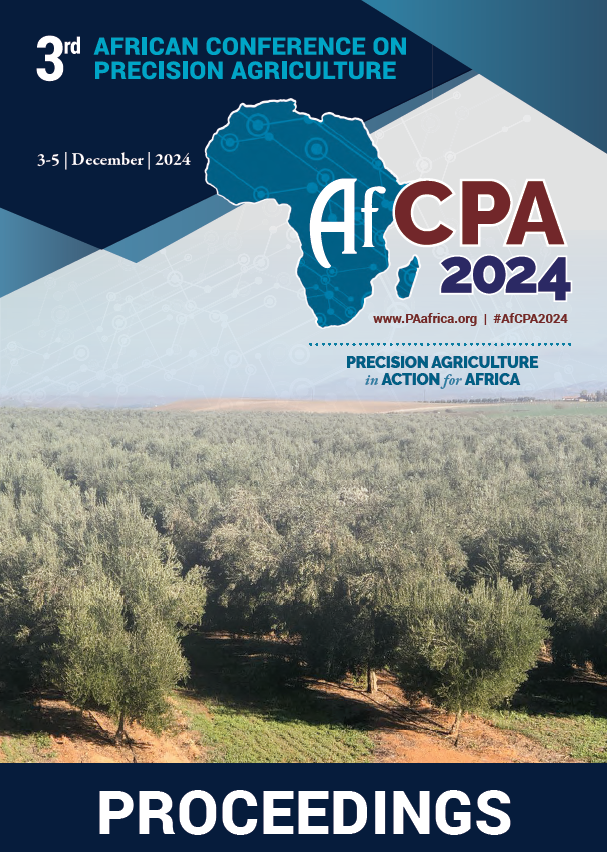Download the Conference Proceedings
Proceedings
Authors
| Filter results9 paper(s) found. |
|---|
1. The Vision of Future Earth Observation for AgricultureThe main objective of EO4AGRI is to catalyze the evolution of the European capacity for improving operational agriculture monitoring from local to global levels based on information derived from Copernicus satellite observation data and through exploitation of associated geospatial and socio-economic information services. EO4AGRI assists the implementation of the EU Common Agricultural Policy (CAP) with special attention to the CAP2020 reform, to requirements of Paying Agencies, and... K. Charvat, V. Safar, H. Kubickova |
2. SmartAfriHub for SmartAgriculture capacity buidling in AfricaDigital Innovation Hubs (DIH) are multi-actor ecosystems that support farming communities in their digital transformation by providing a broad variety of services from a one-stop shop. DIHs purpose is to provide a social space for community of practices; provide access to digital technologies and competencies; provide access to infrastructure and tests digital innovations (“test before invest”); provide development playground... K. Charvat, C. Miderho , A. Obot, T. Löytty, H. Kubickova |
3. SIMULATION OF CASSAVA YIELD UNDER DIFFERENT CLIMATIC SCENARIOS IN KILEMBWE, SOUTH-KIVU PROVINCE EASTERN DR CONGOClimate variability and change are projected to significantly impact agricultural production across Africa. This study assessed the effects of climate variability and change on cassava yield in Kilembwe, South-Kivu province Eastern DR Congo. The assessment relies on the DSSAT crop model simulation of cassava under current and future climate. The period 1980–2010 was used to represent the baseline, while future projection covers three periods including the near future (2010–2039), mid-century... A.B. Yamungu, A. Egeru, M.J. Majaliwa, B.M. Dossa |
4. Precision Farming Technology to Increase Soil and Crop Productivity in Egypt Using Remote Sensing and GISPrecision farming or site-specific land management is a new approach for development the agriculture processes to increase the soil and crop productivity with saving efforts and costs. Precision farming includes many techniques such as Global Position Systems (GPS), Geographic Information Systems (GIS), Remote Sensing (RS), Yield Monitors, Internet of Things (IOT), Variable Rate Application (VRA), Yield Mapping, Site-Specific Management Zones (SSMZ) and Crop Modeling. SSMZ delineation can be improved... A. Belal, M. Elsayed , M.E. Jalhoum, M. abdelatif , E. Hendawy , M. Emam, M. Zahran |
5. Effect of Plant Population and Nitrogen Rate on Growth and Yield of Two Pre-release rice varieties in KenyaThe application of precision agriculture (PA) through the optimization of plant population and management of fertilizer nitrogen (N) can increase rice yield. Current rice (Oryza sativa) plant population and fertilizer nitrogen (N) management guidelines in Kenya were developed from research conducted about three decades. These management guidelines might still be robust and could be applied to recently released as well as close-to- release varieties. However, the yield potential of... W. Kioko, W. Kioko, W. Kioko, W. Kioko, O. Kitonyo, G. Chemiming'wa, S. Gebeyehu, R. Murori |
6. The Yield Gap In Africa: Closing the gap through soil attributes management using remote sensing & Precision Agriculture Approaches at the field scaleIn Africa, which has the most population growth in the world, the agricultural system is characterized by the predominance of smallhoder farmers. In order to cope with intense population growth and increased production costs through yield gap closing. Yield gap is defined as the difference between potential yield and actual yield and is an inevitable method to improve yields while decreasing the environmental impacts of agricultural systems. The variability of yields is strongly controlled by... K. Khechba, A. Laamrani, A. Chehbouni, D. Dhiba, K. Misbah |
7. Monitoring irrigation water use at large scale irrigated areas using remote sensing in water scarce environmentIncreasing pressure on available water resources in semi-arid region will affect the availability of water for irrigated agriculture. In this context, adoption of innovative and cost-effective tools for water management and analysis of water use patterns in irrigated areas is required for an efficient and sustainable use of water resources. This study aims to evaluate a remote sensing-based approach which allows estimation of the temporal and spatial distribution of crop evapotranspiration... M. Kharrou, V. Simonneaux, M. Le page, S. Er-raki, G. Boulet, J. Ezzahar, S. Khabba, A. Chehbouni |
8. Factors Influencing Farmers’ Decisions on Timing and Application Rates of Irrigation Water in Semi-Arid Regions: A Case-Study of Mwala, Machakos County, KenyaThis study investigates the factors influencing farmers’ decisions on water application in arid and semi-arid regions, where water shortages are prevalent due to low and unreliable rainfall. The research involved interviewing 41 farmers registered under the Equity Group Foundation extension scheme, focusing on their irrigation scheduling techniques, timing, application rates, and other factors such as plant and soil conditions. The study also involved laboratory analysis of soil samples... D. Mongína, C.K. Gachene, G. Kironchi |
9. High-Throughput Field Phenotyping of Ascochyta Blight Disease Severity in Chickpea Using Multispectral ImagingAscochyta blight (AB) caused by Ascochyta rabiei (Pass.) Labr. is an important and widespread disease of chickpea (Cicer arietinum L.) worldwide. The disease is particularly severe under cool and humid weather conditions, leading to crop losses at all stages of chickpea growth. Screening for resistant cultivars remains the most effective, economical and ecological method of disease management. However, traditional phenotyping methods that relying on trained experts are... F. Ibn el mokhtar, S. Krimibencheqroun , , A. Harkani , H. Houmairi , O. Idrissi , E. Abdellah , E. Abdellah |
